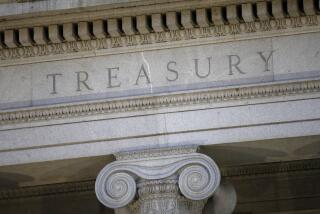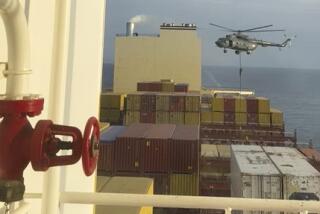Ancient Routes Mean Iran Can Buck Trade Ban
- Share via
DUBAI, United Arab Emirates — The weathered wood vessels stretch for miles along Dubai Creek, often moored three or four to a single berth. Despite smothering 104-degree heat, a steady stream of trucks and carts deliver crates of everything from Pepsi to Pampers, Duracell batteries to Black & Decker appliances, all to be packed in the deep holds and decks of the waiting dhows.
Leaning against his boat, Captain Aziz boasted that the Eagle, a creaking dhow with sky-blue trim, last week hauled parts for GM cars and Caterpillar earthmoving equipment. Captain Ahmed of the Nourallah--or so his dhow was called last week--said he recently transshipped U.S. oil drilling equipment.
Much of this merchandise is bound for Iran.
Thanks partly to dhows that have plied the quiet blue-green waters of the Persian Gulf for centuries, Iran could be largely unscathed by U.S. sanctions due to go into effect next week. “There’ve always been ways around embargoes. And Iran probably has more ways than most to get around the U.S. ban. Dubai will be a key,” said a leading European envoy in Tehran. “Most Iranians who use American goods probably won’t notice much difference.”
With about 200 U.S. companies based here, Dubai’s ports often look like ads for American products. Other U.S. goods from foreign subsidiaries--Colgate toothpaste from England, Barbie dolls made in China, Nescafe instant coffee from Switzerland--make their way to this regional trading center for re-export.
In Iran, despite 16 years of political tension, American products are still the rage. From Smucker’s fudge-flavored peanut butter, Oreo cookies and microwave nachos to Washington apples, Arkansas rice and frozen chicken, the shelves of big grocers and small kiosks offer a wide range of U.S. foodstuffs and toiletries.
*
And the traffic is not just in consumer goods. American equipment is vital to Iran’s oil industry, the mainstay of its economy. In addition, Iran has lately become the most efficient route to transship American food and supplies to formerly Soviet Central Asian republics.
U.S. products are so plentiful that many foreign envoys and Iranian economists say that unrecorded and illegal traffic probably boosted U.S.-Iran trade to $700 million or so last year, more than double the official figure of $328 million. Some claim it exceeded $1 billion.
In theory, all U.S. trade with and investment in Iran will end on June 6. President Clinton issued the executive order in response to allegations that Tehran is promoting terrorism and developing weapons of mass destruction, including a nuclear capability.
Some trade will stop. Traffic from Dubai’s big formal ports involving goods sold directly by American companies could be severely affected. They’re easier to monitor, U.S. officials say.
But in practice, the large number of dhows and the untraceable middlemen who stock them will be virtually impossible to regulate. So smuggling is likely to increase as legal trade is curtailed.
With dozens of vessels departing daily for 12- to 40-hour hops to Bandar Abbas, Bushehr, Abadan and other Iranian ports, Dubai will undoubtedly become the kind of economic lifeline to Iran that South Africa was to sanctioned Rhodesia in the 1970s, economists in Dubai and Tehran contend.
The need is mutual. Over the past five years, Iran has been either the No. 1 or No. 2 trading partner of Dubai, which is the second-largest of the seven United Arab Emirates and one of the world’s leading transport and distribution centers.
For every dollar of goods imported to Dubai, an estimated 70 cents’ worth is re-exported elsewhere. Up to half those goods go to Iran.
“The fortunes of Dubai depend on what happens in Iran,” said an Asian commercial attache here.
Iran is so integrated into the Dubai market that the rial is a widely used currency here. Merchants can also trade on credit or barter with carpets and pistachios.
The links are not just economic.
Of Dubai’s population of 500,000, about 70,000 are Iranian passport holders and another 70,000 with local citizenship are of Iranian origin, envoys say. Many Iranian families have relatives on both sides of the Gulf. Most are involved in trade.
Dubai is not the only option for supplying Iran. Land routes via Turkey and sea routes from Oman and Pakistan offer other smuggling alternatives.
Laden with American cigarettes and other light items, giant speedboats from Al Khasab, on the tip of the Omani peninsula, dart across the Gulf daily to Bandar Abbas. Most of the goods come from Dubai.
“Persians have been among the world’s best traders for over 2,000 years. This kind of game they’ll play very well,” said an Asian commercial attache.
Iran’s biggest vulnerability is U.S. oil equipment. But weeks before Clinton ordered the sanctions, the National Iranian Oil Co. began scrambling to stock up on American spare parts. When those run out, more will probably become available.
*
In some cases, agents of Canadian companies visiting Tehran say they will be able to supply Iran with acceptable substitutes for U.S. parts. And when Iran needs specialized American-made equipment, such as drilling bits or turbines, middlemen are likely to find some way to procure them.
Iran is already dismissing the embargo’s impact.
“The issue of sanctions is over. It made its little echo and passed away. It was more important for internal U.S. consumption than for its impact on us,” said Rajai Khorasani, former U.N. ambassador and now a member of the Iranian Parliament’s foreign affairs committee.
Tehran was briefly abuzz with talk of imposing a counter-ban on all American goods to demonstrate Iran’s independence, but nothing came of it. “It was an opinion-making move by hard-line students who take anti-American slogans more seriously than others,” Khorasani observed in an interview. “But the parliamentary agenda is already set, and we can’t jump into something new. There’s no need to respond.”
Politically, the embargo could be a boon, providing a means of rallying support both inside and outside Iran.
Most important, it unifies a divided government.
“A year ago, the United States said there were no radical factions and no moderate factions in Iran. Sanctions will make this prophecy true. Now there’s not one person who could come out and say one word pro-American. On foreign policy, all factions are united,” said a leading Asian diplomat in Tehran.
Since the 1979 upheaval that replaced 2,500 years of monarchy with an Islamic republic, Iran’s ruling mullahs have repeatedly used crises, such as a 1980 invasion by Iraq, to revive public interest in the revolution.
Abroad, Iran actually looks at least slightly stronger as a result of the announced U.S. sanctions.
A year ago, Tehran was largely isolated on the diplomatic front. But the U.S. embargo has forced countries to take a stand. Virtually all of them, even Canada and Britain, opted to sustain ties and trade with Tehran rather than join the United States.
“Iran can say: ‘See how many friends we have. The Russians are still going to give us the [nuclear] reactor, and America’s closest friends are still trading with us,’ ” a top European diplomat said.
In fact, the U.S. ban on trade and investment could open up new alliances--in turn triggering new alarm bells in Washington.
“We may see a closer alliance with Iraq as part of an effort to jointly defy the United States. This would be a major development,” said Hadi Semati, a political scientist at Tehran’s Center for Strategic and Middle East Studies.
The longstanding enemies, whose bloody 1980-88 war resulted in more than 1 million casualties, last week announced a tentative breakthrough in relations. Iran’s foreign minister will soon visit Baghdad to try to resolve an array of outstanding issues.
Yet the planned embargo hasn’t been without impact.
In the financial realm, it is a major psychological blow at a critical juncture in Iran’s spiraling economic crisis, which predates the ordering of the embargo.
After weeks of watching the rial plummet, the government this month in effect cut the currency’s value in half and put all currency transactions under state control.
It also ordered all Iranian exporters to repatriate foreign earnings. Of about $5 billion earned last year from non-oil exports, less than $500 million came back to Iran, government officials say.
The moves mark a reversal of the sweeping liberalization program introduced in 1990 that symbolized a new era after the death of Ayatollah Ruhollah Khomeini in 1989.
“Efforts at liberal reform are now dead. The actions the government took indicate the system is malfunctioning altogether,” said Ali Rashidi, a Tehran economist.
Even before the new measures, economic woes were expected to force Iran to renegotiate its foreign debts--already rescheduled once--when payment begins falling due early next year. Over the next four years, Tehran is supposed to pay debt service of at least $3.5 billion annually, roughly 20% of its estimated export earnings, according to European figures.
The decline of the dollar internationally has hurt Iran too. The income it receives from oil sales is pegged to the dollar, but its debts to other countries are often in other currencies. As the dollar loses value against those currencies--it is down about 20% against the Japanese yen--Iran is forced to allocate an ever greater share of its precious oil revenue to debt payments.
To show it means business, the regime introduced the death penalty for “economic sabotage.” But on the first business day after the decree, a thriving black market was in full swing, undermining government credibility.
“The Iranian economy is increasingly out of control, and in that sense it is vulnerable to the psychology of sanctions,” said a Western envoy in Tehran. “But unlike a lot of other countries under sanctions--Cuba, Rhodesia and Vietnam, for example--Iran still has vast assets. This country is more than likely to muddle through indefinitely.”
More to Read
Sign up for The Wild
We’ll help you find the best places to hike, bike and run, as well as the perfect silent spots for meditation and yoga.
You may occasionally receive promotional content from the Los Angeles Times.






